You are reading the older HTML site
Positive Feedback ISSUE
19
may/june 2005
golden sound
The Intelligent Chip, the Magic Ring, and the Ultra Tweeter - Three new gizmos from Golden Sound
as reviewed by Marshall Nack
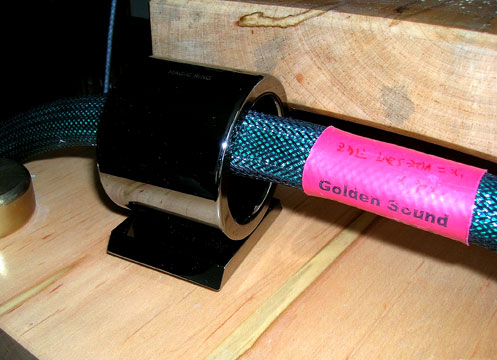
|
MARSHALL NACK'S SYSTEM
LOUDSPEAKERS
ELECTRONICS
SOURCES
CABLES
ACCESSORIES
|
By now, you have probably gotten wind of the controversy surrounding Golden Sound's Intelligent Chip (GSIC). At the last CES, Golden Sound started the pot a'stirring by its initial release. At same the time, some audio reviewers with their sample, ran from room to room, brandishing the chip, and spreading the word. Online chat rooms chimed in, pro and con. Subsequently, Stereophile magazine joined the fray on no less than three occasions, always on the side of the Doubting Thomases, with cannon-fodder from the big guns: John Atkinson, Jim Austin and Sam Tellig. Now, just arrived, is the latest Stereophile eNewsletter (June 2005) and I could hardly believe my eyes—here was another broadside. This time it was Ken Kessler…only as I began to read, it became clear he was coming in on the affirmative. He reports these were "…the most successful listening sessions I'd ever witnessed… a dozen seasoned audiophiles…were, to a man, able to distinguish treated from untreated discs with alarming consistency." But then he finishes up with a wishy-washy "…it's still too early to write off the Golden Sound Intelligent Chip as mere audiophile drivel." Well, this is not the conclusion I would have come to with his results. Moreover, nobody has stepped forward to say what these things actually sound like. It is shaping up like a redux of the old objectivist vs. subjectivist debate.
But wait—there's more! Golden Sound introduced three products at the same time, and all operate on the same theoretical principles. So why spill all your spleen on the GSIC alone? Save some for the Magic Ring and the Ultra Tweeter.
Golden Sound Intelligent Chip
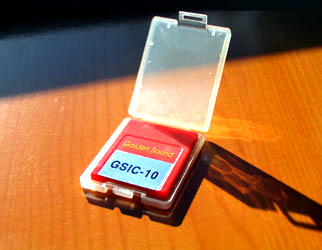
From the Golden Sound website: "The Intelligent Chip is a thin, orange 1 x 1.5 inch rectangular wafer that automatically upgrades the disc in the player when the Chip is placed momentarily on top of the player above the spinning disc. The upgrade itself is virtually instantaneous—and permanent..." The very brief explanation that follows talks about problems "…produced by slight fluctuations in the master clock(s) when pressing the disc… The Intelligent Chip corrects the clock-fluctuation problem within 2 seconds." The corrected disc is claimed to sound, "clearer/less distorted, with a deeper soundstage, more "air", and lower background noise".
How does it accomplish this? No clue is given. The omission of a credible explanation—a mistake on the part of Golden Sound—only serves to add fuel to the fire. I only know from talking to GS proprietor Allen Chang that the GSIC and the two other products employ developments from the frontiers of quantum mechanics theory, things that government and private research labs worldwide are working on. If you read periodicals like Scientific American, this is not news. It is pretty exciting, actually—quantum mechanics is going to make our lives better. We will soon see the trickle-down application of this technology in consumer goods. It is just unfortunate that Golden Sound had to discover it could be painful on the cutting edge.
Now I do not pretend to understand quantum mechanics. Nor do I believe I have to. Do I know what is inside the Harmonix Room Tuning Discs or how they work? I approached the GSIC the same as I would any other tweak—I put it in and listened for a difference.
Was there a difference? Yes—most of the time. I A/B tested the GSIC for multiple listeners in my system and a friend's. All but once, the differences were obvious. That means nine times out of ten everyone heard a difference. (I think there was too much talking and distraction the other time). A GSIC treated CD is easy to pick out, not that it sounds hugely different from an untreated one. Just as you learn to hear differences among cables, you learn to hear what the chip changes. Then it becomes easy to spot.
My experiment involved three originals of Mozart Night Music, two red book versions (harmonia mundi HMU907280), and one hybrid SACD (HMU807280), plus multiple originals of two other CDs, one on harmonia mundi and one from Bridge Records.
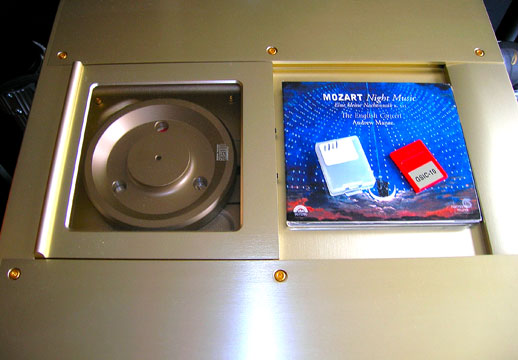
The English Concert led by Andrew Manze is splendid on Mozart Night Music, their debut album with Manze at the helm. There's a good deal of candy here for classical Top Forty lovers, but also some surprises, like the Adagio and Fugue in C minor (tracks 5 & 6), which breaks away from formulaic nostrums—it doesn't sound at all like the Mozart most of us are familiar with. The playing throughout is impeccable. In fact, one classical maven complained that it is too articulate; he thought there should be more softness on the attacks and sloppier ensemble playing. Huh? Anyhow, there are plenty of instrumental effects and the sonics on the CD have the usual excellence we have come to expect from harmonia mundi, so this was prime testing material.
The low strings sounded pretty good. Then I zapped one copy with the GSIC and they changed. There had been a nice acoustic umbrella or halo around these strings, which I felt added to the complexity of the instrument's sound. It certainly made them sound better than the bare bones note, although they could have sounded richer and more open. Well, that acoustic umbrella went bye-bye. Listening to the GSIC treated disc made it clear that, in reality, the acoustic umbrella was one more form of noise. It was coating everything with the same quality and consequently blurring the picture.
The GSIC managed to remove that coating. I was reminded of those old Drāno commercials—pour some into the bowl and, voila, the pipe becomes unclogged. The key thing is that, instead of leaving you with the skeletal remnants of a note, something quite nice appeared—the instrumental overtone structure was laid bare and, along with it, the richness and differentiation among these strings. This was noticed first in the bass, which firms up and becomes mucho articulate, then in the midrange, in violin and viola tone. My audience had nothing but kudos for this effect.
The treble was impacted somewhat differently. In my system, which tends to the warm side, first violins can still sound like white noise. There is an acoustic halo, as with the lower frequencies (with a stronger resemblance to artifact in this band), which is drained, taking with it the shrillness and warming up the metallic cast. The highs begin to exhibit texture and realistic violin tone—but unlike the low frequencies, some true treble energy is also flushed. The treble gets cleaned but also slightly reduced. The upshot is enhanced purity, more body, greater soundstage focus and a slightly darker tonal balance. This is great for those of us who have problems with treble balance and noise, but if you are one of the few who have a clean and balanced frequency response, you will not like this reduction.
You may be curious to know that of the three Mozart Night Music discs, the GSIC treated one was judged to be in the middle; the hybrid SACD came in first. The SACD went even further in the directions of the GSIC. This was a surprise, because, in my experience, hybrid SACDs played on 16 bit machines usually sound worse than red-book. In this case, maybe it has to do with the gold color of the metal substrate on the backside of this SACD (most discs have aluminum substrates). A few years ago, some companies experimented with gold substrates—it did not fly commercially due to the higher MSRP, but they sure sounded better. Gold CDs are warmer and smoother. (Today, gold Mo-Fi's command premium prices on the used market.) It's clear there are all kinds of things that effect CD sound—where it was pressed (some plants have better quality controls), which country it was pressed in (as usual, those manufactured in Japan are more highly prized), how it was mastered, not to mention the whole host of consumer level after-market, third-party treatments, like green pens, cream polishers, special mats to place on top and edge shavers. I find it amusing that one can be just as neurotic about CD provenance and care as any old rabid LP collector can—we haven't escaped the neuroses after all. Come to think of it, why should we? Isn't this obsessive pursuit of quality what we are doing in every other aspect of this endeavor?
"The Intelligent Chip is available in two models—the GSIC10 ($16) upgrades 10 discs; the GSIC30 ($40) upgrades 30 discs." That is right; it knows how many discs you have treated. For those who were curious and opened one up looking for a counter, there ain't one. For that matter, there is not much of anything inside, just a miniscule quantity of active material, enough so the GSIC 10 can treat 10 discs. As you use it, it is depleted. The tenth disc exhausts the material. Simple, yes? It works on all commercial CD/DVD/SACD discs, including movies and video games.
Golden Sound Magic Ring
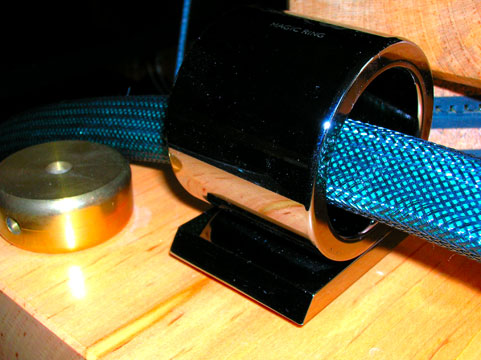
Website description: "Standard size) is a 1 3/4-lb, dark metallic-gray, thick-walled cylinder with OD = 2 7/16 inch, L = 2 1/2 inches and H = 2 13/16 inches (including flat base). The Large Magic Ring weighs 2 1/4 lb, with OD = 2 5/8 inch, L = 2 11/16 inches and H = 2 15/16 inches (including base)." The Magic Ring (MR) is a wide diameter, heavy metallic tube. Just stand it on its base and run your audio wire through it—no problem fitting even the biggest power cords into its generous mouth. At first glance, the MR may remind you of a very large version of the ferrite core EMI/RFI blockers that clamp onto a wire. Ain't no similarity, however. The rings work on the principle of "energy organization" in materials that conduct signals or electricity, just like the GSIC, and have nothing to do with conventional principles such as magnetism, vibration control or shielding. What does it sound like?
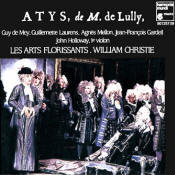
Here's another late harmonia mundi beauty of LP engineering: Atys, by Jean-Baptiste Lully, with William Christie and Les Arts Florissants (HMC 1257.59). This three LP box set from 1987 has more recitatif than instrumental passages, but still, c'est trés bien for performance and its recorded acoustic. At first I had the CD, which I promptly disposed of—the digital transfer sounded dreadful—and now I have the vinyl. Anyway, with one MR alongside the Harmonix Studio Master power cord to the preamp, aside from the reduction in the mechanical signature, I hear significant opening up when the supporting chorus joins in. (It's very easy to do A/B testing. Although the strongest effects come from running the cable through the MR, you will get 75% or so just by placing the wire on top of or alongside it.) Where the chorus sounded all bunched up and massed, their space is MUCH better defined, layered behind the soloists, and more reverberant, apparently further from the mike(s). Now you can hear the range of voices in the chorus, and the effect does not clamp down on the natural dynamics or constrain them in any way. Take away that single MR and the sopranos exhibit obvious strain and edge—this can't have been present at the recording, it has to be the playback. Surround a few more power cords with MRs and the effect compounds. One can't fail to note the increased clarity, focus, beauty of tone and the opening up of the soundstage—the same as with the GSIC treated CD, including the same caveats (principally, the treble will be shelved down a bit). I demonstrated the MR reliably and repeatedly in three high-res systems.
Anyway, what I want to note is the powerful effect these rings had on most of the speaker cables I tried them with and especially the Harmonix Studio Master power cords. However, very little happened with the Audio Note SPc speaker cable and AN LPz interconnects. Results seem quite variable depending on the wire you have in place.
The Ultra Tweeters
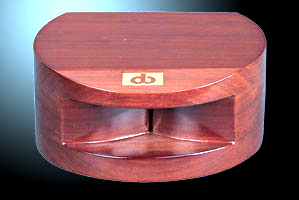
"(The) Ultra Tweeter principle of operation is very unconventional. They do not generate sound in the audio band, or even in the 20-100kHz band like super-tweeters, but function in the Gigahertz frequency band (normally used for satellite and microwave communications). Ultra Tweeters organize and improve the energy flow in signal conductors as well as the internal wirings of speaker drivers, making the audio system perform more efficiently and synergistically."
The Ultra Tweeters look like miniature wooden horns. Unlike super tweeters, they do not produce anything audible. Their small sound output is so high up in the ultrasonic frequency range you cannot hear them. Consequently, you can place them anywhere, even facing the wall. What they do, it is claimed, is make the speaker's parts work more efficiently. Huh?
Again, there was no doubt about the changes. I tried them on my Kharma CRM 3.2s and the Hørning Agathon Ultimates, two very different speakers. It was definitely more relaxed, with a newfound ease and smoothness. The presentation became softer, frequency transitions were more graceful and supple, and this applied across the frequency spectrum, not just the top. The tonal balance did get lighter, but this was due to a more energetic upper-midrange, rather than more treble. One ill effect: macro dynamics were slightly impacted.
Creeping Refinement
Those very things I liked about the Mozart Night Music CD—the articulation, sharp attacks, perfect ensemble playing—are enhanced with the MR and GSIC. There is no doubt about the improvements in beauty of tone, clarity and focus. Then the question becomes, do you like it? Can you have too much clarity?
It is a little like adding sugar to your morning cuppa-jo. I like one tsp; give me more and I recoil. Two MRs strategically placed in the Single Ended Triode rig I am listening to right now was just right. A quartet of rings did the trick when I switched to my push-pull vGA Nirvana tube amps and the Kharma 3.2s. Adding one more to either set up was too much. The reduction in noise and artifact can result in more clarity than the real thing—it can become unnatural sounding.
Then there is the treble balance. In the SET rig, I managed to get it just right. Adding an MR disturbed this with its slight suppression of the top end. (At the same time, almost all other aspects of the presentation were improved).
Then there is the "Drāno Effect" of the GSIC and the MR. This elicited universal kudos on the low register, but got mixed reviews on the treble. The cleanup removed the acoustic cloud surrounding the instrument and caused some to complain about missing "air". I hear what they are talking about. Now, you may like this "air"—it sounds like it could be intrinsic to the instrument, maybe some of its natural bloom. Conceivably so. I liked it, too, until I heard what it sounds like without it. Then I listened intently to what happens naturally. Now that I am sensitized to it, I can say the only time I hear this is in audio systems.
Conclusion
So, what is all the fuss about? For me, it is like any other gadget—put two Magic Rings on a couple of power cords and see what happens. If it does not work in your rig, return them—it will not be the first tweak you try that does not cut it. Do you need to understand the principles of operation involved in any of these products? I A/B'ed the Golden Sound Intelligent Chip in my system and one other—nine times out of ten, listeners reported a difference. I tried the Magic Ring in three systems and always noticed a difference. I am quite willing to concede they may not work everywhere. Many tweaks are like that. Chances are you will hear a change, something along the lines of adding some more power conditioning. Then again, if you do not think power conditioners make a difference, you should probably close your browser right now.
(I would like to add an experience I have had with the chip here in my own home, though rather an informal one. Using two copies of the Kimber Iso-Mike disc, I "treated" one with the chip and left the other au naturel. With Bob Levi and John Cassler sitting in the sweet spot, I played the two discs in various orders and repetitions (something like treated, treated, untreated, treated, untreated, treated, untreated, untreated, treated, etc.). While they both found there to be a difference, they were not conclusive in which was which, nor if one was really that much "better" than the other. That is, both could tell the discs apart to some degree though not to any that would suggest that the treated disc was superior to the untreated disc. On the other hand, sitting in the adjacent dinning room having lunch were Francisco Duran and Fown-Ming Tien who both were able to identify which disc was which 100% of the time, and in doing so, both found the treated disc to be FAR superior to the untreated disc in terms of musicality, resolution, etc.. From listening off axis and casually, they both could easily discern the treated disc from the untreated disc, as well as appreciate its positive effect on the music. Weird to say the least. Perhaps an issue of casual versus intensive listening? The power of burgers? All knew what I was doing, that is the disc had been treated with the chip, though none of them knew really much about the chip. Nor were they aware of which disc was which, as I preformed this as a rather casual single blind test. Dave Clark)
The Golden Sound Magic Ring, Intelligent Chip and Ultra Tweeter do things similar to other products that work on quantum mechanics principles, like those from Jack Bybee and Bill Stierhaut's QRT—you will find these of kindred spirit. They are all good medicine in purging the electro/mechanical residue from your system and promoting a naturalistic presentation. They "do everything that pushes the audiophile buttons", as more than one listener said to me.
I keep thinking how, if these products had come around sooner, before I had amassed my present battery of third-party palliatives, there is a good chance I would be salivating over them. I use many things to enhance tone and anoint with an acoustic patina—the Acoustic System Resonators, Harmonix Tuning Feet and Room Tuning Discs (read Marshall's review here), ERaudio Space Enhancer component boards (read Marshall's and Dave Clark's reviews), etc. I shuffle them in and out depending on the effect I am looking for. The Golden Sound products join this list of powerful and positive tweaks. Once the MRs were in, I did not want them out. In addition, once I tasted the GSIC, I planned to treat my entire collection.
Golden Sound will continue to take advantage of this technology—a whole host of new products are in the pipeline. So ladies and gentlemen, make sure you have enough ink for what is coming.
Golden Sound Magic Ring
Retail: Regular $180, Large $300
Intelligent Chip
Retail: 10 CD Chip $16, 30 CD Chip $40
Ultra Tweeter
Retail: (pair) $400
Golden Sound
P.O. Box 1293
McLean, VA. 22101
TEL: 888. 811. 5818 or 703. 847. 2617
email address: [email protected]
web address:
www.dhcones.com
